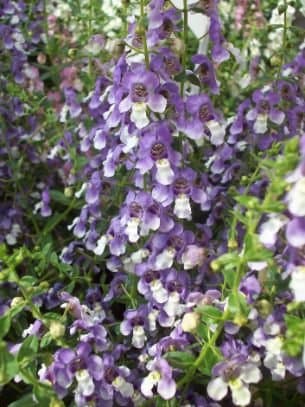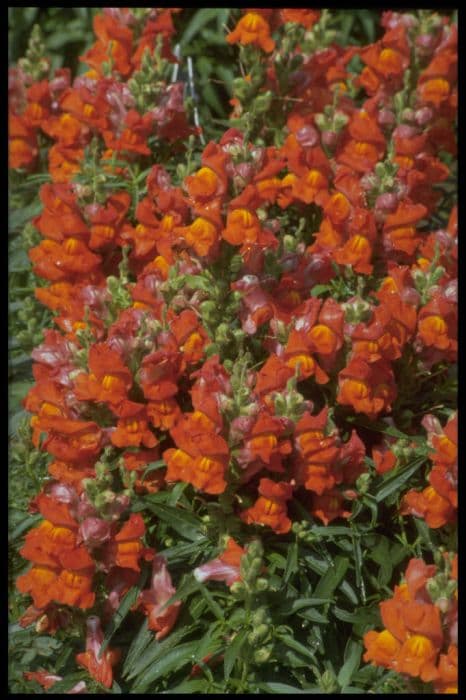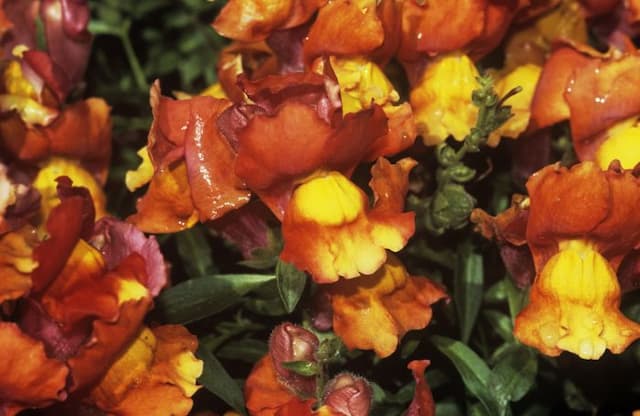Shrubby Veronica Hebe macrantha

ABOUT
The Hebe macrantha, widely known by its common name, is a bushy evergreen shrub that boasts a multitude of striking features. It has a dense growth habit with dark green, glossy leaves that provide a lush backdrop throughout the year. These leaves are lance-shaped, often exhibiting a leathery texture which adds to their robust appearance. Flowering predominantly in the summer, it produces abundant inflorescences that consist of small, trumpet-shaped blooms. The flowers emerge in dense clusters, creating a spectacular display of color that can range from deep violet to rich purple, adding to the ornamental value of the plant. These blossoms are particularly attractive to bees and butterflies, which further enhances the lively character of the shrub when in bloom. The Hebe macrantha is known for its resilience and can create an eye-catching feature in gardens, thanks to its evergreen foliage and the profusion of flowers that adorn the plant during blooming season. The overall aesthetic of the shrub is one of robustness and vitality, making it a favored choice for gardeners seeking to add a touch of enduring beauty to their landscapes.
About this plant
 Names
NamesFamily
Plantaginaceae
Synonyms
Large-Flowered Hebe, Showy Hebe
Common names
Hebe armstrongii, Hebe dieffenbachii, Hebe pinguifolia, Hebe pinguifolia var. macrantha, Veronica macrantha
 Toxicity
ToxicityTo humans
Hebe macrantha, commonly known as the Hebe plant, is not widely recognized for being poisonous to humans. Information regarding its toxicity is limited and it does not have a prominent reputation for causing harm upon ingestion. If you suspect poisoning from any plant, it is important to seek medical advice.
To pets
The Hebe plant, which includes Hebe macrantha, is not generally known to be toxic to pets. It is not listed among the common poisonous plants to dogs and cats. However, it is always wise to prevent pets from ingesting plants, as individual plants may cause varying reactions in different animals. If your pet shows signs of illness after ingesting any plant, contact your veterinarian.
 Characteristics
CharacteristicsLife cycle
Perennials
Foliage type
Evergreen
Color of leaves
Green
Flower color
Purple
Height
3-5 feet (0.9-1.5 meters)
Spread
3-5 feet (0.9-1.5 meters)
Plant type
Shrub
Hardiness zones
8
Native area
New Zealand
Benefits
 General Benefits
General Benefits- Attracts Wildlife: Hebe macrantha provides nectar and pollen for bees and other pollinating insects.
- Garden Aesthetics: With its attractive foliage and flowers, it adds aesthetic value to garden spaces.
- Low Maintenance: Known for being easy to care for once established, requiring minimal upkeep.
- Durability: It is a relatively hardy plant that can withstand various environmental conditions.
- Versatility: Suitable for borders, containers, and as a ground cover, offering various landscaping uses.
- Evergreen: Retains its leaves throughout the year, providing year-round interest in the garden.
 Medical Properties
Medical PropertiesThis plant is not used for medical purposes.
 Air-purifying Qualities
Air-purifying QualitiesThis plant is not specifically known for air purifying qualities.
 Other Uses
Other Uses- Floral Arrangements: Hebe macrantha’s vivid flowers and foliage can be used in fresh or dried floral arrangements to add a unique texture and color.
- Habitat Restoration: This plant is sometimes used in habitat restoration projects as it is attractive to local wildlife and can help stabilize soil.
- Erosion Control: Due to its dense growth habit, Hebe macrantha can be planted on slopes or banks to help prevent soil erosion.
- Garden Borders: The plant's compact form makes it an ideal choice for defining the edges of garden beds and paths.
- Privacy Screening: When planted in groups, Hebe macrantha can function as a low, informal hedge for privacy in garden settings.
- Topiary: Some gardeners shape Hebe macrantha into topiary forms, enjoying its ease of trimming and maintenance.
- Bonsai: With careful pruning, this plant can be trained as a bonsai specimen, offering a challenge for bonsai enthusiasts.
- Cultural Significance: In some cultures, Hebe macrantha may be used in ceremonial plantings or as part of symbolic gardens.
- Photography: The plant is often featured in garden photography due to its stunning flowers and structural interest.
- Wildlife Garden: Its flowers attract pollinators such as butterflies and bees, making it a beneficial addition to a wildlife-friendly garden.
Interesting Facts
 Feng Shui
Feng ShuiThe Hebe plant is not used in Feng Shui practice.
 Zodiac Sign Compitability
Zodiac Sign CompitabilityThe Hebe plant is not used in astrology practice.
 Plant Symbolism
Plant Symbolism- Youth: Hebe is the Greek goddess of youth, and the plant named after her is often associated with eternal youth and rejuvenation.
- Vitality: Due to its lush and vigorous growth, the Hebe plant symbolizes robust health and vitality.
- Unity: With its clusters of flowers, Hebe is sometimes used to represent unity or solidarity in diversity, with each individual bloom contributing to the whole.
- Protection: Some believe Hebe plants have protective qualities, guarding against negative influences and fostering a safe environment.
 Water
WaterThe Hebe, commonly known as the 'Veronica', requires consistent moisture but should not be overwatered. Water the plant deeply to encourage root growth, generally amounting to about 1 gallon per week for established plants, but this may vary depending on climate and soil conditions. During the growing season in spring and summer, watering frequency should be increased, especially in hotter, drier climates. However, in winter, reduce watering to prevent root rot, catering only to the plant's reduced needs. It is critical to ensure the plant is in well-draining soil to avoid waterlogged conditions.
 Light
LightThe Veronica thrives best in full to partial sunlight. It should be placed in a spot where it receives at least 6 hours of direct sunlight per day but is shielded from the intense midday sun. The ideal location would allow for morning sunlight and afternoon shade, offering a balance that encourages healthy growth without scorching the foliage.
 Temperature
TemperatureThe Veronica prefers cool to moderate temperature conditions, thriving best between 50°F and 70°F. It can tolerate minimum temperatures down to about 20°F, but frost can damage the plant. Ideally, ensure the plant is protected from extreme temperature swings and harsh winter conditions.
 Pruning
PruningPruning the Veronica is important to maintain shape, encourage bushier growth, and remove any damaged or diseased stems. Light pruning can be done any time of year, but major pruning should occur in early spring before new growth starts. Prune no more than one-third of the plant at a time to avoid stressing it.
 Cleaning
CleaningAs needed
 Soil
SoilThe best soil mix for Hebe (often called Shrubby Veronica) is a well-draining soil with peat moss or compost added for fertility. The ideal pH range for this plant is between neutral to slightly alkaline (pH 7.0 to 7.5). A mixture of two parts garden soil, one part peat moss or compost, and one part perlite or coarse sand would create an ideal environment for root growth.
 Repotting
RepottingHebes, like the Shrubby Veronica, should be repotted every 2 to 3 years to refresh the soil and provide room for growing roots. It's best to repot in spring before the growing season begins. Ensure the new pot is only slightly larger than the old one to avoid excess soil moisture leading to root rot.
 Humidity & Misting
Humidity & MistingShrubby Veronica prefers moderate humidity levels but is quite adaptable. Aim for a humidity level around 40-50%. They are resilient in different humidity conditions, which makes them suitable for most indoor environments without the need for additional humidity control.
 Suitable locations
Suitable locationsIndoor
Provide bright indirect light and good airflow indoors for Hebes.
Outdoor
Plant in well-draining soil and a sunny to partly shaded spot outdoors for Hebes.
Hardiness zone
8-11 USDA
 Life cycle
Life cycleHebe macrantha, also known as Large-Flowered Hebe, begins its life cycle with seed germination, which requires a well-drained substrate and should ideally take place in warm temperatures. After germination, the seedlings grow into juvenile plants, establishing a root system and beginning to produce characteristic foliage. As the plant matures, it enters the vegetative stage, where it focuses on leaf and stem growth, forming a dense, shrubby habit. The reproductive phase follows, during which Hebe macrantha produces large inflorescences of purple or violet flowers, attracting pollinators and leading to potential cross-pollination. After pollination, the plant develops seed capsules, which eventually dry and release seeds, thus completing the life cycle. In favorable conditions, Hebe macrantha can live for many years, with some shrubs reaching 15 years or more, going through multiple cycles of growth and reproduction.
 Propogation
PropogationPropogation time
Spring-Early Summer
The most popular method for propagating Hebe macrantha, commonly known as the Hebe plant, is through semi-hardwood cuttings. This process typically takes place during the late summer months. To propagate by semi-hardwood cuttings, one would select healthy, non-flowering shoots from the current year's growth and cut a piece around 4 to 6 inches (approximately 10 to 15 centimeters) long. The lower leaves are stripped off, and the cut end can be dipped in rooting hormone to encourage root production. The cutting is then inserted into a pot filled with a mix of peat and perlite or sand to provide good drainage and aeration. The pot should be placed in a warm, sheltered spot but out of direct sunlight, and the cutting must be kept moist until roots have developed, which usually takes a few weeks. Once rooted, the new Hebe plant can be transferred to a larger pot or directly into the garden.









